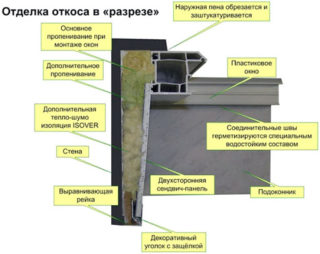The thickness of the window frame is narrower than the end part of the wall, therefore, when installed in the opening, external and internal slopes are obtained, which require finishing. Well-designed ends contribute to the aesthetic assessment of the facade and interior. The decoration of the slopes of plastic windows is determined by the requirement for heat preservation, prevention of condensation, the cost of materials and installation. Window framing increases its durability and acoustic parameters.
The need to finish the slopes of plastic windows
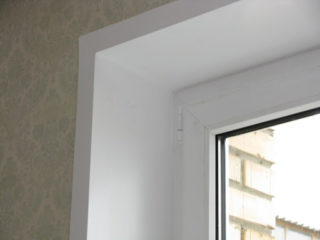
It is widely believed that sheathing serves to decorate a window opening from the inside and outside of an apartment, but the elements of the opening have many other purposes. Initially, the material hides mounting fixtures, foam residues, fasteners, uneven brick or concrete.
Other functions of window cladding:
- provides thermal insulation, protects against drafts;
- protects against noise;
- prevents the development of fungi, microorganisms, the appearance of mold;
- prolongs the service life of the window sash.
The windows are placed in the opening so that an assembly gap remains between the frame and the walls in case of shrinkage or distortion. This distance is foamed, after drying, the protruding residues are removed with a knife.
The foam, when solidified, forms a protective film, if you cut it off, the inner layer begins to decompose from moisture and temperature changes. The cladding of the slopes creates a closed microclimate, so the destruction process stops. The cladding helps to equalize the external and internal temperatures, condensation does not form on the slopes.
Features of various materials
Polyurethane foam panels are often used, which are characterized by rigidity. Such window decoration inside does not require alignment, since the panels have verified dimensions. They are seated on glue, subsequently putty on the grid, painted with tinted paints.
The disadvantages include the susceptibility of the material to the formation of dents during strong point impacts; in the event of a fire, it emits harmful components into the surrounding air.
Sandwich panels are lightweight, almost do not conduct heat, resist moisture, and are easy to clean. The disadvantage is the loss of whiteness and the appearance of a yellow coating when exposed to ultraviolet radiation.
Foamed PVC is placed on arched slopes, since the material is easily bent when applying cross cuts. This material has a small selection of colors.
Finishing elements will work on the verge of outside and inside temperatures, so they are chosen taking into account certain requirements:
- duration of work in the structure without loss of original properties;
- modern look and combination with plastic windows;
- low moisture saturation, resistance to low temperatures, freezing;
- good thermal insulation or the possibility of using it together with insulation;
- safety under the action of aggressive atmospheric chemistry.
In the thickness of the wall, when installing the window, cold bridges are obtained at the junction of the frame and the wall. Through them, heat is lost in fences made of brick, concrete, therefore, slopes are required to be insulated. The protection material is polystyrene, expanded polystyrene, polyurethane foam, which have minimal water absorption.
Mineral wool is rarely used when decorating windows inside and outside, since it gets wet from condensation and no longer protects from the cold. For cotton wool, according to the instructions, you need to make a ventilated gap, but in the conditions of window slopes this is not always feasible.
Plastering and painting
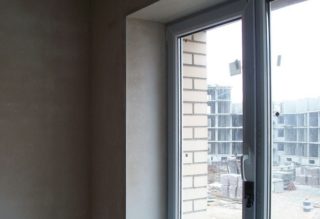
For plaster, a solution consisting of sand and cement at a concentration of 1: 3 is used. If a thick layer needs to be applied, pieces of brick are used to reduce the volume of the mortar cover. A fine metal or plastic mesh is placed in the layer to prevent cracks on the surface. Small coats are applied with a starter putty, which is sold as a dry mix.
Plaster fills all gaps tightly and is a durable finish. Liquid glass is added to the solution, the layer after drying does not get wet, does not allow water to pass through. The frozen solution is a weak insulator against cold, therefore thin layers sometimes freeze. Ready-made dry mixtures based on polymers are produced warm - anti-freeze additives are added, fibrous elements are included.
The surface requires finishing with fine-grained compounds. Before applying, the area of the slopes is primed with deep penetration compounds, putty is applied, then cleaned with diamond meshes for smoothness. They are painted with latex acrylic paints that are easy to clean.
Drywall
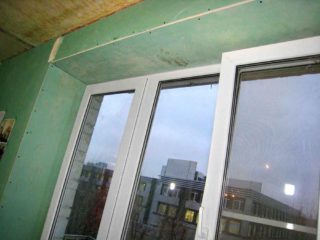
Trim the slopes with plasterboard steel due to the versatility of the material. The option is notable for its low cost, it is simply installed on the frame or glued to the beacons. The sheets allow you to finish the arched structures of the slopes using a special bending technology. Finishing window slopes inside the frame method allows you to mount a layer of insulation of the required thickness.
They use types of material that can work in conditions of high humidity and the risk of condensation. Such sheets are produced in green. The design of the slope is characterized by rigidity, strength, the possibility of various finishes on the surface of the material.
For the frame, use:
- bearing profile CD-60;
- strapping guides UL-25;
- bracket ES 60, 90 mm long.
The staples are installed to concrete or brick using plastic dowels with self-tapping screws, and metal profiles are connected with flea beetles. Self-tapping screws for metal with frequent threads are used to fix drywall sheets. The surface of the finished structure is primed, putty and painted.
Plastic slopes
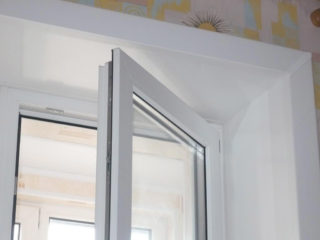
PVC is suitable for finishing the inner slopes of plastic windows and outside the building. Practical plastic is affordable and durable. The inner sections form an air gap, so the material does not conduct heat well and additionally protects from the cold. PVC panels are mounted using the frame method or glued to the installed beacons.
An insulating layer is placed inside the structure, which does not collapse under conditions of protection with a plastic coating. Siding can be considered a kind of PVC, but this type is used for outdoor decoration. They produce plastic of various colors with imitation of natural stone, wood, fabric braiding. The surface does not require additional painting, putty, easy to clean with conventional products, hygienic.
The disadvantages include susceptibility to ultraviolet rays, from which low-grade versions of colored plastic can fade and lose color. White panels turn yellow, sometimes warp on the sunny side of the apartment.
Decorative rock
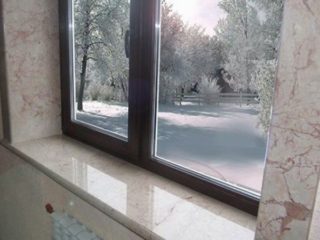
Finishing made of natural material is rarely used due to its high cost.To replace the expensive stone, decorative artificial varieties are produced, which in appearance almost do not differ from natural ones. On the surface, a layer is made that imitates onyx, marble, granite, basalt and other types.
The composition includes gypsum or cement binder, fillers, pigments for painting. They use pumice, tuff, expanded clay, perlite. The mass of such elements is half that of natural ones. The surface of the tiles is smooth with sawn edges or has a torn texture with uneven edges. The decoration of the slopes of the windows inside is done with elements 1.5 - 2 cm thick.
The tiles are painted over the entire mass during the production process, therefore, when chipping off, a defect in the form of a white spot will not be visible. The material resists moisture, contains additives that increase thermal insulation properties.
Elements based on gypsum are cut with a hacksaw, and for cement ones, a grinder or a circular saw with a corresponding disc for a stone is used.
Metal
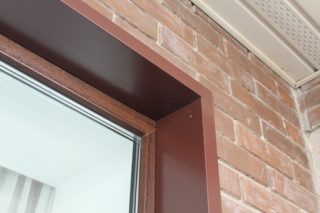
In unpainted form, such slopes are rarely set, more often they use coated material. A powder composition is applied to the surface, which is melted in high-temperature chambers. A layer based on ebonite resin forms a durable cover on the metal, which protects the material from rust, moisture and temperature extremes.
They take aluminum, galvanized steel, and stainless steel as a basis. The material is referred to as cold varieties, therefore, insulation is used in the design of the slopes. The painted smooth surface goes well with plastic frames, such materials are used for exterior finishing of the ends or placed inside, if the style of the interior allows. Metal panels are available in different colors.
Metal slopes are well washed, do not require regular painting, and are used for a long time. The external elements do not deteriorate from rain and resist the action of aggressive chemicals in the atmosphere, and also protect the room from possible drafts.
Required tools and consumables
Slopes are set using different technologies, hence a different list of materials for work. Plastic options require a galvanized profile for the frame, screws and dowels for fixing. PVC strips are framed with corners, starting strips, and after installation, the seams are sealed with acrylic sealant to match the surface color.
The tools also depend on the type of finish. Prepare for plastic:
- tape measure, building level, pencil, square;
- hand hacksaw for metal, knife, miter box;
- puncher, screwdriver;
- sealant gun, screwdriver.
The decorative stone is placed on glue mixtures, which are sold in the form of a dry powder. Grouting compounds are used to process the joints between the tiles. Drywall at the joints is glued with a serpentine mesh, which is installed on the finishing putty. Materials for plastering depend on the type of composition used; it is better to take ready-made mixtures with improved qualities. The surface is primed with adhesives, painted with acrylic paints, sometimes oil paints are used.
DIY finishing features
PVC finishing instructions:
- install the guide rails of the frame made of a galvanized profile or a wooden strip impregnated with linseed oil on the dowels to the base of the wall;
- put starting strips or corners where the ends of the plastic panels will be led;
- with a tape measure, determine the pieces of plastic panels in place separately for each piece;
- the parts are cut off and set so that the ends are closed with initial moldings, the elements are connected with grooves and depressions along the length, they are attached to the rails with “fleas”;
- after the installation of the last panel, the cracks and seams are sealed with acrylic sealant.
The angle of rotation of the plane of the slope relative to the frame is called dawn, due to this, the amount of light entering the room is increased. Slopes must not be placed at an angle of 90 ° to the plane of the window, since.it gives the impression of a loophole in a tower or hospital room. So that the dawn on both sides of the window and in other openings in the room is the same, they make a template for their plywood, wood, chipboard.


